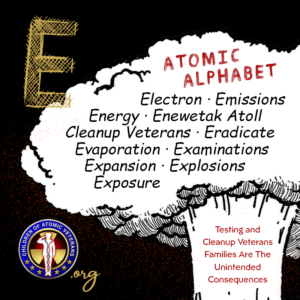
News
Atomic Alphabet – “D” is for…
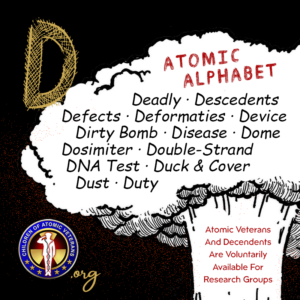
Atomic Alphabet – “C” is for…
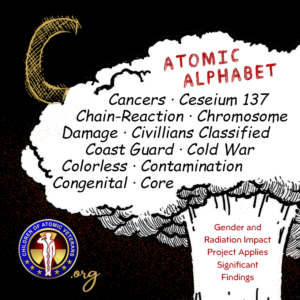
Atomic Alphabet – “B” is for…
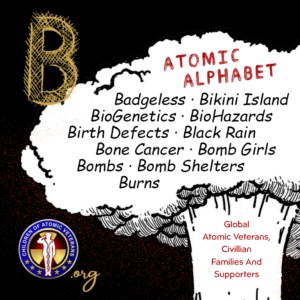
Atomic Alphabet – “A” is for…
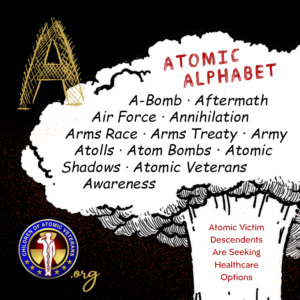
Marshall Islands Nuclear Remembrance Day: March 15-20th
Marshall Islands Nuclear Remembrance Day is a multi-day event to honor the victims and survivors of the nuclear testing done in the Marshall Islands.
Here is some background on why remembrance remains deeply important.
Nuclear Weapons Production in Washington State
- Before the nuclear tests even started, they had a toxic legacy. The uranium that was used in the weapons was largely sourced from Midnite Mine, a uranium mine that was built on the Spokane Tribe of Indians’ Reservation creating massive contamination for the community. The Spokane Tribe of Indians were heavily impacted by the adverse health effects caused by Midnite Mine. Despite closing in 1981, it was listed as a Superfund site in 2000, and the clean-up of the mine did not begin until 2017, allowing waste to pollute the area for 36 years.
- Additionally, the nuclear weapons that were tested on the Marshall Islands utilized plutonium that was produced at Hanford. Hanford is a former nuclear weapons site in the Tri cities, established as part of the Manhattan Project in 1943. Located on the ancestral lands of the Yakama Nation, Hanford is home of the B reactor, the first full-scale plutonium production reactor in the world. It was responsible for producing plutonium for the bomb dropped in Nagasaki as well as the first nuclear weapons ever tested in New Mexico. Hanford is now the largest environmental clean-up effort in the world, and the most contaminated site in the western hemisphere.
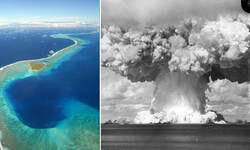
1946-1958: United States Nuclear Testing
- When the Marshallese community tended to negotiate further treaties and establishments with Americans, they did not expect massive destruction to occur on their islands.
- Following other colonial regimes, Japan established military bases in the Marshall Islands in 1914. They expected the Marshallese to assimilate into their war efforts and colonial era to gain their power away from American colonialism. Although the Marshallese were mistreated by the Japanese, they did not want to acknowledge anything else with them as they saw American power tend to be gained. In 1944, during WWII, the United States defeated Japanese troops in the Marshall Islands and converted their bases into U.S. bases.
- About 2 years later, during the early years of the Cold War, the United States decided to utilize its military presence in the Marshall Islands to conduct nuclear tests.
- Between 1946 and 1958, the U.S. conducted 67 nuclear tests on the Marshall Islands. The Bravo detonation that took place in 1954 was the most massive nuclear weapon ever detonated by the United States – and it was accompanied by many other massive-scale detonations. This testing of atomic and hydrogen bombs amounted to one Hiroshima bomb every day, for 12 years. The fallout spread throughout the islands.
- The U.S. Government had decided not to evacuate downwind communities, and after the explosions, enrolled residents of the downwind Rongelap and Utrik communities into a secret medical experimentation program.
- Around 200 people whose islands were directly bombed were relocated to different islands during the tests; during this time, many communities faced malnutrition and starvation due to inadequate resources.
- This testing changed the lives of the Marshallese significantly. The detonations threatened the well-being of Marshallese communities when they first occurred, and the pollution has since made the previously-available natural resources scarce.
Enewetak Atoll Atomic Cleanup Veterans
The U.S. dispatched American soldiers and civilian contractors for nuclear clean-up, without informing them of the nuclear radiation risk they would be taking on.
- Those involved in the clean-up process were also not provided with adequate personal protective gear.
- Today, these clean-up veterans and civilian contractors have extremely high rates of cancer, with some individuals developing multiple different forms.
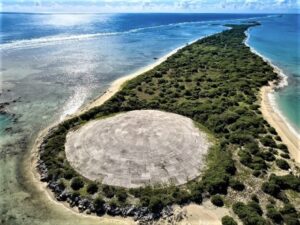
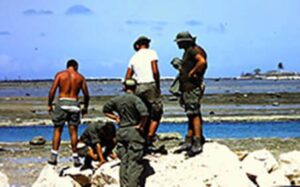
1986: Compact of Free Association (COFA)
- In 1986, the U.S. signed the Compact of Free Association into law. COFA is an international agreement with the U.S. and the Republic of the Marshall Islands (RMI) as well as the Republic of Palau and the Federated States of Micronesia.
- COFA states that Marshallese people have the right to live and work in the U.S. and can even serve in the U.S. military. However, Marshallese people do not have an automatic right to permanent residency.
- A 1996 federal welfare reform act made COFA communities ineligible for Medicaid: this posed a major issue, as many COFA communities have high rates of chronic diseases and health issues due to the legacy of U.S. nuclear testing.
- Recent victory: in 2020, due to the effort of amazing organizers, COFA islanders residing in the U.S. became eligible once again for Medicaid
Today: Lingering Impacts
- The health injustices that these nuclear tests caused, including cancer, thyroid disorders, stunted growth, developmental delays, and birthing anomalies, are still being felt by many, including Marshallese elders, children, and cleanup veterans.
- The contamination still lingers in the soil, water, and local food of certain areas. The populations of Bikini and Rongelap have still not been able to return to their islands due to toxic contamination as well as segments of the Enewetak community.
- Today’s climate crisis poses yet another layer of risk to the Marshall Islands. As the sea level rises, large sections of the Marshall Islands are at risk of being submerged.
- This is particularly concerning because, during the “clean-up” process, the U.S. moved contaminated debris and soil to Runit Island and dumped it into a crater that was later filled with concrete. Today, as the water rises, researchers have cited concern that this tomb of atomic contamination may be vulnerable to leaking if exposed to sea level rise and storms.
- The Runit Dome is a control structure located on Enewetak Atoll. Enewetak Atoll is a previous U.S. air atomic weapon test site in the Marshall Islands. According to the Department of Energy (DOE), the amount of plutonium beneath the dome surface contains one percent of the overall amount buried in the sediments of the nearby lagoon, and is less than 0.1 percent of the plutonium produced more than 60 years ago during weapon tests.
- The pervasive COVID-19 is constraining the Marshallese population to confront the immense imbalances in our environment that have made this virus more dangerous in a few communities than in others. Moreover, this is also valid within the world of nuclear weapons tests have, and continue to do, damage to societies across a hurtful and often dangerous radius.
- In the forthcoming month of March, the Marshallese community in Spokane, Washington, will have this vital history. Come join us to remember this important history, honor the brave work of frontline communities and unite in battling for equity that is long overdue. It will be in fortitude with other Marshallese narrators, and other affected networks in Washington state, and across the US. Particularly during this season of disengagement, we will be hosting this event online to ensure these accounts keep on being told and permit a period for aggregate mending in recognition of the people in question/survivors to the ages that follow. We need to perceive the flexibility and strength of transcending atomic forces, enhance the voices that should be heard, and remind this community that we are not alone.
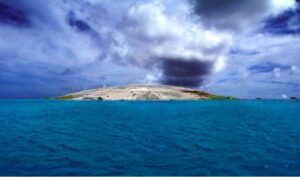
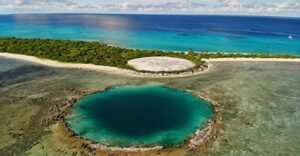
Event logistics
Marshall Islands Nuclear Remembrance Day will take place March 15-20 2021, and will be virtual. To RSVP: visit bit.ly/Nuclear-Remembrance-RSVP
Mark Takai Healthcare Parity Act
PRESS RELEASE
For Immediate Release: March 3, 2021
U.S. REP. GRACE MENG, U.S. SENATORS TINA SMITH AND THOM TILLIS LEAD BIPARTISAN PUSH TO SUPPORT HEALTH CARE FOR VETERANS EXPOSED TO RADIATION
Mark Takai Atomic Veterans Healthcare Parity Act Would Ensure Radiation-Exposed Veterans Who Cleaned Up Nuclear Testing Sites in Marshall Islands Receive Health Benefits
WASHINGTON, D.C. – Today, U.S. Rep. Grace Meng (D-NY) and U.S. Senators Tina Smith (D-Minn) and Thom Tillis (R-NC) reintroduced their bipartisan bill in the House and Senate to secure health care benefits for “Atomic Veterans” who were exposed to harmful radiation when they cleaned up nuclear testing sites during the late 1970s.
The Mark Takai Atomic Veterans Healthcare Parity Act would allow veterans who participated in the cleanup of Enewetak Atoll on the Marshall Islands to receive the same health care and benefits given to other servicemembers who were involved in active nuclear tests. From 1946 to 1958, the U.S. military conducted more than 40 nuclear tests in the islands, but the thousands of servicemembers who cleaned up the area were never made eligible to receive health benefits under the Radiation Compensation Exposure Act.
“Veterans who helped clean up Enewetak Atoll—which was the site of over 40 nuclear tests conducted by the United States—deserve access to VA benefits and critical care for exposure to radiation and nuclear waste,” said Congresswoman Meng. “These veterans have higher rates of cancers and diseases but are currently unable to receive the same treatments and service-related disability presumptions that other ‘radiation-exposed veterans’ receive. This error must be corrected, and I am proud to reintroduce this legislation with Senators Smith and Tillis to make that happen. We must help these veterans and I look forward to Congress passing our bill and sending it to President Biden’s desk.”
“We have a solemn duty to take care of the men and women who serve in our armed forces—a big part of that means ensuring they can get the health care they need both during and after their service.” said Senator Smith. “Americans who cleaned up the radiation-exposed Marshall Islands—where more than 40 nuclear tests took place in the 20th century—have been fighting for proper care for a long time. We need to stand up for them, and we can do so by delivering on this commonsense, bipartisan fix.”
“The courageous servicemembers who were assigned to cleaning the fallout and debris from nuclear tests in the Marshall Islands without protective gear in the 1970s deserve the highest quality medical care,” said Senator Tillis. “The fact that those servicemembers have had to fight for the same level of care as other radiation-exposed veterans is a systemic failure we must correct. This bipartisan legislation is long overdue and will ensure that those veterans receive access to the medical treatment they are entitled to.”
The bill is named after the late Hawaii Congressman Mark Takai, a veteran of the U.S. Army and Hawaii Army National Guard who passed away in 2016 and was the original sponsor of the bill in the House of Representatives.
The servicemembers who participated in the Marshall Islands cleanup between 1977 and 1980 suffer from high rates of cancers due to their exposure to radiation and nuclear waste, but are currently unable to receive the same treatments and service-related disability presumptions that other “radiation-exposed veterans” receive. The Mark Takai Atomic Veterans Healthcare Parity Act would tackle this issue by extending key VA benefits to those who helped clean up the Marshall Islands, which remain partly uninhabitable due to high levels of radiation.
A copy of the bill can be viewed here.
Best wishes to everyone for the New Year.
Best wishes to everyone for the New Year. Be Safe. Stay Positive. Test negative. Have Hope. Get inspired!

Thank you for your service, support and encouragement as we add to the awareness and recognition for our tribe.
No Medal Yet…
Instead of Medals, The Pentagon Is Offering Certificates To Vets Who Were Exposed To Radiation
A Time-Lapse Map of Every Nuclear Explosion Since 1945
Credit: Artist Isao Hashimoto
A beautiful, undeniably scary time-lapse map of the 2053 nuclear tests which took place between 1945 and 1998 (3 min.)
Beginning with the Manhattan Project’s “Trinity” test near Los Alamos and concluding with Pakistan’s nuclear tests in May of 1998. This leaves out North Korea’s two alleged nuclear tests in this past decade (the legitimacy of both of which is not 100% clear). Each nation gets a blip and a flashing dot on the map whenever they detonate a nuclear weapon, with a running tally kept on the top and bottom bars of the screen. Hashimoto, who began the project in 2003, says that he created it with the goal of showing”the fear and folly of nuclear weapons.” It starts really slow — if you want to see real action, skip ahead to 1952 or so — but the buildup becomes overwhelming.